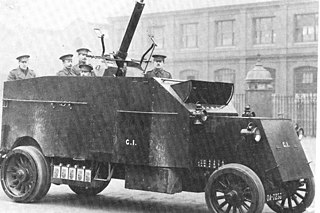
An armoured fighting vehicle (AFV) is an armed combat vehicle protected by armour, generally combining operational mobility with offensive and defensive capabilities. AFVs can be wheeled or tracked. Tanks, armoured cars, assault guns/armoured self-propelled guns, infantry fighting vehicles and armoured personnel carriers (APC) are all examples of AFVs.

A tank destroyer, tank hunter, tank killer, or self-propelled anti-tank gun is a type of armoured fighting vehicle, armed with a direct fire artillery gun or missile launcher, designed specifically to engage and destroy enemy tanks, often with limited operational capacities.

Crusader, in full "Tank, Cruiser Mk VI, Crusader", also known by its General Staff number A.15, was one of the primary British cruiser tanks during the early part of the Second World War. Over 5,000 tanks were manufactured and they made important contributions to the British victories during the North African campaign. The Crusader tank would not see active service beyond Africa, but the chassis of the tank was modified to create anti-aircraft, fire support, observation, communication, bulldozer and recovery vehicle variants.

The Rolls-Royce Armoured Car was a British armoured car developed in 1914 and used during the First World War, Irish Civil War, the inter-war period in Imperial Air Control in Transjordan, Palestine and Mesopotamia, and in the early stages of the Second World War in the Middle East and North Africa.

AEC Armoured Car is the name of a series of British heavy armoured cars built by the Associated Equipment Company (AEC) during the Second World War.

The Ordnance QF 2-pounder, or simply "2 pounder gun", was a 40 mm (1.575 in) British anti-tank gun and vehicle-mounted gun employed in the Second World War.

The Marmon-Herrington Armoured Car was a series of armoured vehicles that were produced in South Africa and adopted by the British Army during the Second World War. RAF Armoured Car companies possessed them, but seem never to have used them in action, making greater use of Rolls Royce Armoured Cars and other types.

The Vickers Medium Mark II was a British tank built by Vickers in the Inter-war period.

Car, Armoured, Heavy (Aust), also known as Rhino, was an armoured car designed in Australia during the Second World War. Due to enemy action and design problems the project never got beyond a prototype stage.

The Lanchester armoured car was a British armoured car built on the chassis of the Lanchester "Sporting Forty", it saw wide service with the Royal Naval Air Service and British Army during the First World War. The Lanchester was the second most numerous World War I armoured car in British service after the Rolls-Royce armoured car.

During the First World War, sixteen American Peerless trucks were modified by the British to serve as armoured cars. These were relatively primitive designs with open backs, armed with a Pom-pom gun and a machine gun, and were delivered to the British Army in 1915. They were used also by the Imperial Russian Army as self-propelled anti-aircraft guns.
Tanks of the Second World War

The Ordnance QF 3-pounder Vickers was a British artillery piece first tested in Britain in 1903. It was used on Royal Navy warships. It was more powerful than and unrelated to the older QF 3-pounder Hotchkiss, with a propellant charge approximately twice as large, but it initially fired the same Lyddite and steel shells as the Hotchkiss.

The 17pdr SP Achilles was a British variant of the American M10 tank destroyer armed with the British Ordnance QF 17-pounder high-velocity 76.2 mm (3-inch) anti-tank gun in place of the M10's considerably less powerful 3-inch Gun M7. A total of 1,100 M10s were converted to Achilles, making it the second most numerous armoured fighting vehicle to carry the 17-pounder gun, behind the Sherman Firefly tank.

Throughout its history, the Irish Army has used a number of armoured fighting vehicles.

Tanks have been employed by the military forces in Italy since their first use in World War I. They have had continued use in wars after and are still used through the modern day. The C1 Ariete is the current main battle tank of the Italian Army.

The Delaunay-Belleville armoured car was a British armoured car built on the chassis of the luxury French Delaunay-Belleville tourer. It saw service with the Royal Naval Air Service in the early years of the First World War.

The Pierce-Arrow armoured AA lorry was a self-propelled anti-aircraft carrier mounting a QF 2-pounder AA "pom-pom" gun, it was used by the Royal Marine Artillery during the First World War.

The Pierce-Arrow armoured lorry was a heavy armoured car mounting a QF 3-pounder Vickers gun, it was used by the Royal Naval Air Service during the First World War.

The Talbot armoured car was a British armoured car built on the chassis of a Clément-Talbot tourer. Built in small numbers to several patterns, the Talbot armoured cars saw service with the Royal Naval Air Service (R.N.A.S.) in the early years of the First World War, serving alongside Rolls-Royce and Delaunay-Belleville armoured cars.




















